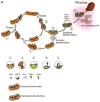Mitochondrial dynamics: the intersection of form and function
- PMID: 22729853
- PMCID: PMC5967395
- DOI: 10.1007/978-1-4614-3573-0_2
Mitochondrial dynamics: the intersection of form and function
Abstract
Mitochondria within a cell exist as a population in a dynamic -morphological continuum. The balance of mitochondrial fusion and fission dictates a spectrum of shapes from interconnected networks to fragmented individual units. This plasticity bestows the adaptive flexibility needed to adjust to changing cellular stresses and metabolic demands. The mechanisms that regulate mitochondrial dynamics, their importance in normal cell biology, and the roles they play in disease conditions are only beginning to be understood. Dysfunction of mitochondrial dynamics has been identified as a possible disease mechanism in Parkinson's disease. This chapter will introduce the budding field of mitochondrial dynamics and explore unique characteristics of affected neurons in Parkinson's disease that increase susceptibility to disruptions in mitochondrial dynamics.
Figures



References
-
- Abou-Sleiman PM, Healy DG, Wood NW. Causes of Parkinson’s disease: genetics of DJ-1. Cell Tissue Res. 2004;318(1):185–188. - PubMed
-
- Arakaki N, et al. Dynamics of mitochondria during the cell cycle. Biol Pharm Bull. 2006;29(9):1962–1965. - PubMed
-
- Arbuthnott GW, Wickens J. Space, time and dopamine. Trends Neurosci. 2007;30(2):62–69. - PubMed
Publication types
MeSH terms
Substances
Grants and funding
LinkOut - more resources
Full Text Sources
Miscellaneous

